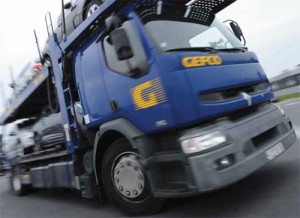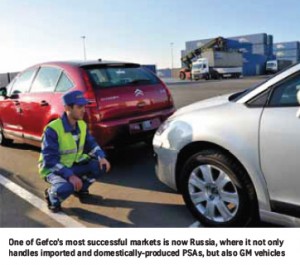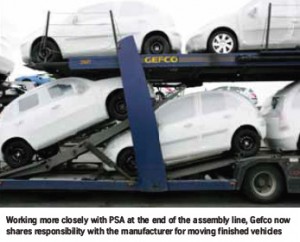Gefco is using its strong position to expand globally and acquire assets for vehicle logistics, both as the outbound arm of the PSA Group and as it diversifies its customer base, writes Christopher Ludwig.
Gefco stands out in the vehicle logistics industry as one of the few companies offering a pan- European network as well as in its ambitions to become a global provider. Thanks to volume from the PSA Group, growth with non-group customers and its acquisitions in the marketplace, Gefco is now expanding with assets and compounds on the ground in markets like Russia, Central Asia, India and South America.
The strength of its network in Europe is possible in part because Gefco, as a subsidiary of PSA Peugeot-Citroën, can be considered the carmaker’s outbound logistics arm. The group gives Gefco a foundation in more than 100 countries, particularly in Europe, as PSA volume provides a base for the 3,000 trucks the carrier operates (70% of which are subcontracted), its fleet of 3,600 rail wagons and 80 compounds. In part, Gefco’s ability to offer competitive services to other carmakers also depends on PSA, since it can use supplementary volume from other brands to fill trucks or wagons with Peugeot and Citroën, especially in Europe where Gefco handles all PSA vehicles (2.2m units in 2010).
 But Gefco is now pushing forcefully beyond Europe. “We know that it is not Europe that is going to show growth and that is why we are expanding in South America, India, etc.,” says Antoine Redier, vice president of vehicle logistics. Gefco’s growth strategies are led by diversification outside the group and by asset investment and acquisition in Europe and globally, including a 70% stake in Italy’s Mercurio Group this past spring–a company with a significant presence in India Southeast Asia and South America. Redier also sees room to expand internally by taking over more operations for PSA in global markets and even in Europe for some functions.
But Gefco is now pushing forcefully beyond Europe. “We know that it is not Europe that is going to show growth and that is why we are expanding in South America, India, etc.,” says Antoine Redier, vice president of vehicle logistics. Gefco’s growth strategies are led by diversification outside the group and by asset investment and acquisition in Europe and globally, including a 70% stake in Italy’s Mercurio Group this past spring–a company with a significant presence in India Southeast Asia and South America. Redier also sees room to expand internally by taking over more operations for PSA in global markets and even in Europe for some functions.
On the acquisition trail
Until recently, Gefco’s proportion of non-PSA turnover for outbound was smaller than it was for other business units like inbound logistics. In 2010, non-group turnover across Gefco was €1.2 billion ($1.7 billion), around 36% of the company’s €3.35 billion revenue. Prior to the Mercurio acquisition, non- PSA business represented 15-18% of outbound turnover but Mercurio’s customers bring it to 25%, according to Redier. Gefco’s target is to increase this proportion to 50%. “The reasoning behind the Mercurio acquisition was first to secure capacity. Secondly, Mercurio is strong where we are interested in the future,” says Redier. “For example, Gefco was already working with Mercurio subsidiaries in South America.
There will be further developments of Mercurio in Southeast Asia and this is exactly the direction that Gefco wants to go.” With Mercurio, Gefco has secured more local capacity. In India, the acquisition puts the company in control of the Mercurio Pallia joint venture, an important player on the market with around 550 trucks. Furthermore, Redier anticipates that if the company grows with the Indian market, the truck fleet should increase by 100 units per year over the next five years. In September, PSA also announced plans to build a plant in Gujarat, in northwestern India, which should also present future opportunities for Gefco in the country. Similarly, in South America, the acquisition strengthens Gefco’s Argentine operations, notably because its primary truck operator, BSM, is a Mercurio subsidiary. “It means that we are now at home in Argentina,” says Redier, pointing out that BSM works with carmakers other than PSA.
With Mercurio, Gefco has secured more local capacity. In India, the acquisition puts the company in control of the Mercurio Pallia joint venture, an important player on the market with around 550 trucks. Furthermore, Redier anticipates that if the company grows with the Indian market, the truck fleet should increase by 100 units per year over the next five years. In September, PSA also announced plans to build a plant in Gujarat, in northwestern India, which should also present future opportunities for Gefco in the country. Similarly, in South America, the acquisition strengthens Gefco’s Argentine operations, notably because its primary truck operator, BSM, is a Mercurio subsidiary. “It means that we are now at home in Argentina,” says Redier, pointing out that BSM works with carmakers other than PSA.
Mercurio–whose brand will remain intact–is unlikely to be the last acquisition in Gefco’s pursuit of global growth; when asked if other purchases are in the pipeline, Redier confirms without hesitation. “There are targets,” he says, declining to specify further except to say that Gefco seeks to widen its market presence rather than to destroy weaker competitors. “We don’t view ourselves as a predator. The goal is to have organic growth but to develop in areas where we need to be stronger. It is less about targeting specific companies than it is about emphasising specific markets.”
Gefco’s global strategy has been redoubled following the economic crisis. Up to then, Gefco was expanding beyond its  PSA-bound operations overseas, moving aggressively in Russia, building joint ventures in China and exploring opportunities in India. But at the height of the crisis, Gefco pulled back from fledgling operations in China and India. “In 2008 we took drastic actions to reduce our cost base, which is part of the reason for our good results for 2010,” says Redier. “We stopped in places where it was not the right timing, which I think was sensible, and now we are back.”
PSA-bound operations overseas, moving aggressively in Russia, building joint ventures in China and exploring opportunities in India. But at the height of the crisis, Gefco pulled back from fledgling operations in China and India. “In 2008 we took drastic actions to reduce our cost base, which is part of the reason for our good results for 2010,” says Redier. “We stopped in places where it was not the right timing, which I think was sensible, and now we are back.”
The chances for further investment may increase as Gefco produces record results. In the PSA Group’s half-year report for 2011, Gefco outperformed the automotive division in its growth rate for profit; first-half revenue increased by 17.6% to more than €2 billion, while operating income was up 17.2% to €143m. Mercurio added about €46m in operating margin. Those results stood in contrast to PSA’s automotive division, which saw flat global sales and declines in Europe, with profits falling 23% to €405m. Further falls in Europe and slowdowns in emerging markets could threaten Gefco’s global expansion and at the very least puts pressure on the need to diversify.
Russian return
Gefco is building outbound subsidiaries in markets as diverse as Kazakhstan, Bulgaria, Iran and Iraq, while some of its strongest areas of outbound services are currently in Eastern Europe and Russia. Gefco moves Renault cars from the Dacia plant in Romania by rail and truck to Italy, for example. In Russia, General Motors is a larger customer than PSA and Gefco also handles volumes there for BMW.
Gefco maintained investment in Russia during the crisis and has benefitted from the recent recovery, even opening a southern sea route to the Ukrainian port of Ilyichevsk in the Black Sea from Vigo, Spain, southern Italy or Turkey. According to Redier, the route will soon use the Russian port of Novorossiysk for faster customs clearance. While used only by PSA currently, Redier says that it will be a useful entry option for other carmakers and could help offset the imbalance in flows from St Petersburg to Moscow.
 Gefco is investing in assets in Russia as it tries to overcome shortages in truck capacity and a financially weak carrier base. “If we want to deliver the service expected [in Russia], we have to invest in it ourselves because most others cannot do it,” Redier says.
Gefco is investing in assets in Russia as it tries to overcome shortages in truck capacity and a financially weak carrier base. “If we want to deliver the service expected [in Russia], we have to invest in it ourselves because most others cannot do it,” Redier says.
Gefco operates around 100 trucks in Russia and is building a technical distribution centre south of Moscow scheduled to be operational in autumn, beginning with GM and PSA. The compound will be rail-linked, have a paint oven and carry out repairs and post-production operations (PPO). “Although we subcontract such centres in some markets, this will be the first centre outside of [mainland] Europe that we own,” he says, adding that the next location in which Gefco plans to add PPO operations will be Brazil.
Opportunities within the group
Redier is also looking for opportunities within the PSA group, particularly its overseas organisations and joint ventures. In some such plants, Gefco is already the designated provider–at the Tofas plant in Bursa, Turkey, for example, which produces light commercial vehicles for PSA, Gefco is responsible for the releasing operations.
However, for PSA vehicles produced by Mitsubishi in Japan, Gefco only takes responsibility from the port of Zeebrugge. And in China, Gefco is responsible only for imported PSA vehicles, while distribution from joint venture plants with Dongfeng in Wuhan is handled by a Dongfeng logistics subsidiary. However, as PSA is forming a second joint venture plant with Chang’an, Redier says Gefco is in play to handle part of the outbound logistics. “It will be complicated because Chang’an also has a logistics provider and we will have to find ways to work together,” he says.
Besides potential for more PSA volume, Redier has identified areas where Gefco could work more closely with the manufacturer. An example is at the end of the assembly line. In the past, PSA moved cars off the line to compounds while Gefco handled the onward transport in isolation. But since last year, Gefco shares responsibility from the end of the line; this collaboration requires PSA to provide Gefco more visibility on the vehicles scheduled to be produced in the next 48 hours. Having this information and working more closely with PSA has helped Gefco reduce lead times by two days in just a year. Redier says that before, if Gefco was building a load of ten cars for Berlin, for example, but only had eight cars, it would wait indefinitely for the next two. “But what we do now is look into the pipeline and decide how long we would have to wait. With that information, we decide whether it’s worth waiting or trucking with eight cars. Or, we will add two cars destined for Leipzig and avoid wasting capacity,” he says.
That such visibility on forthcoming production was uncommon even between PSA and Gefco highlights the lack of  information-sharing endemic in the outbound supply chain. “Logistics information remains the key,” says Redier. “The golden rule is that you try not to move any goods as long as you don’t have its final destination, otherwise you risk moving a car for no reason.”
information-sharing endemic in the outbound supply chain. “Logistics information remains the key,” says Redier. “The golden rule is that you try not to move any goods as long as you don’t have its final destination, otherwise you risk moving a car for no reason.”
European capacity shifts
While globalisation is important, Europe will nevertheless remain Gefco’s most important market for the foreseeable future, with the majority of its trucks and compounds and all of its rail wagons on the continent. Investment in Europe is targeted towards IT upgrades and fleet renewals–70% of trucks in France were recently brought up to Euro 5, for example–but regulatory shifts may bring further changes to the network and the modal mix.
Redier is unconcerned about transport capacity shortages in shrinking or sluggish markets like France, the UK or Spain, but he acknowledges that many OEMs have pushed providers to the edge of survival with low rates. However, he predicts that the balance will turn. “The market will regulate once there is capacity missing–as we’re seeing in Germany and parts of Central Europe–but overall we are not there yet,” he says. As a purchaser of transport, Redier says that Gefco took a long view on rates following the crisis. As the company subcontracts 70% of its road transport, management believed that if small transport operators went out of business then Gefco would have had to fill the lost capacity itself and offer it to PSA and others at a low rate.
“Investing and then losing money is a real lose-lose, so we decided to support the smaller transport companies by not reducing the rates in Western Europe,” he says. “However, for larger companies that we felt could survive, we were more aggressive.” Redier acknowledges that Gefco cannot go on subsidising carriers; in some dire markets, like Portugal and Spain, he believes more capacity will disappear. “The painful adjustments are underway,” he says.
While sales growth and fleet expansion are unlikely to lead the development in Europe, Gefco is anticipating changes from regulation to limit CO2 emissions and push more freight away from traditional road transport. “We are convinced that rail will become more important because of CO2 regulation in Europe. I cannot imagine that in 5-10 years time we will be allowed to truck 1,000km by road, for example,” says Redier. The European Commission’s white paper on future transport policy, published this past spring, hinted at these transitions; for example, it suggested targets for CO2-free logistics in urban areas by 2030 as well as moving more freight by rail for distances over 300km.
For urban distribution, Gefco will soon have a taste of what could come in its home city of Paris, where there are plans to eliminate trucks larger than 29 square metres in the seven central arrondissements. Gefco plans to deliver cars via barge and train and then drive them individually to dealers. “This is difficult and may not ultimately reduce CO2 emissions. In any case, it is not going to be a cheaper solution,” he says. On the other hand, rail’s share of Gefco’s modal split in Europe has actually fallen recently, dropping from 40% in 2005 to around 20% today, losing out to short-sea (which represents 30% today) and road, which is 50%. Much of the decrease has been in France, but also Italy, Benelux and even Germany. Redier blames the loss of the single wagon system and price hikes that have followed network closures. While he says that rail volume is now stable or increasing slightly, a step change is unlikely without substantial capacity increases and more rail distribution hubs.
Although Gefco recently scrapped about 800 older rail wagons, it will nevertheless expand its rail fleet and trial a new wagon prototype this year with height flexibility. In a sign of increasing competition, Gefco also began using a train this year between Sochaux, in central-eastern France, and Calais in the north that is operated by DB Schenker rather than SNCF, the national French operator. “It’s the first example in France of Gefco not using SNCF,” he says.
IT evolution and an electric future
The immediate future for Gefco will see investment to expand overseas and to strengthen European operations. By the middle of 2012, Gefco will have renewed its IT system in Europe for storage and transport, which includes a standardised process for compounds. The compounds will feature GPS positioning for each car and an optimisation process called ‘twinning’, which eliminates shuttles by matching drivers to cars moving between the workshop, stock or reception areas. In 2013, Gefco will renew its audit and invoice system.
Gefco is also preparing for the arrival of mass-selling electric vehicles by providing training for employees and adding charging stations at its compounds. “The fact that a normal car battery is 12 volts and these cars are 300 volts means that we need to train people to handle them and to be able to reload the batteries,” Redier says. Perhaps most essentially from a management perspective, Redier acknowledges that growth will require a rebalancing of Gefco’s central organisation as it continues to grow around the world, with more personnel and influence from expanding regions.
“Today we have a very centralised management organisation, which is okay as long as Europe is our biggest area,” he says. “But we need to be aware that we cannot implement our services in the same way in all countries–we have to adapt or else we are out.”


























![Global[1]](https://d3n5uof8vony13.cloudfront.net/Pictures/web/a/d/s/global1_726550.svgz)









